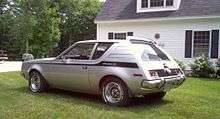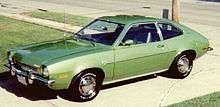Subcompact car


A subcompact car is the American term for an automobile with a class size smaller than a compact car[1] usually not exceeding 165 inches (4,191 mm) in length, but larger than a microcar. According to the United States Environmental Protection Agency (EPA), a passenger car is classified as subcompact if it has between 85 cubic feet (2,407 L) and 99 cu ft (2,803 L) of interior volume.[2]
The subcompact segment equates roughly to A-segment and B-segment in Europe, or city car and supermini in British terminology. In 2012, the New York Times described the differences, saying "today’s small cars actually span three main segments in the global vehicle market. The tiny A-segment cars include the Chevrolet Spark and Smart Fortwo. They are short and light. Slightly larger are B-segment cars like the Ford Fiesta and Chevrolet Sonic. The A- and B-cars are known as subcompacts."[3]
History
In North America, the term "subcompact" is noted by the Merriam-Webster dictionary have been first used in 1960[1], but this description came into popular use in the early 1970s with the introduction of new domestic-built models produced by North American automakers that saw popularity in the marketplace.[4] Previously, cars in this size were variously categorized, including "small automobile" and "economy car."[5] This type of car has been around since the 1940s with the Crosley, and in the 1950s with the captive import, the Nash Metropolitan.[6] A number of imported models, notably the Volkswagen Beetle and various small British cars, were also marketed as "economy" cars during the 1950s and 1960s.



The US automakers responded to the growing popularity of small imported cars from Europe and Japan during the late 1960s.[7] The AMC Gremlin was described at its April 1970 introduction as "the first American-built import" and the first U.S. built subcompact car.[8][9] The Chevrolet Vega and Ford Pinto subcompacts were introduced in September 1970 for the 1971 model year. The domestic subcompact cars were popular with buyers. For example, inventory shortages of the more popular subcompacts (Vega, Gremlin, and Pinto) developed during summer 1973 because of "exceptionally strong" demand for these nameplates all the way through 1974.[10]
The Pontiac Astre, the Canadian-born re-badged Vega variant was released in the U.S. September 1974. The Vega-based Chevrolet Monza and the Pinto-based Ford Mustang II were upscale subcompacts also introduced for the 1975 model year as larger pony cars the Chevrolet Camaro and Ford Mustang sales had fallen. The Camaro was scheduled for cancellation, but sales stabilized with the end of the 1970s energy crisis. The Monza with its GM variants Pontiac Sunbird, Buick Skyhawk, Oldsmobile Starfire, and the Mustang II continued until the end of the decade. The Chevrolet Chevette was GM's new entry-level subcompact introduced as a 1976 model. It was an 'Americanized' design from Opel, GM's German subsidiary. And then there were subcompacts that were imported but sold through a domestic manufacturers dealer network Captive imports, the Renault Le Car and the Ford Fiesta
In 1978, Volkswagen began producing the "Rabbit" version of the Golf in New Stanton, Pennsylvania, a modern FWD subcompact design, and in 1982, American Motors began manufacturing the U.S. Renault Alliance, a version of the Renault 9, in Kenosha, Wisconsin, both models benefiting from European designs, development, and experience.[11]
The 1979 Mustang moved to a larger platform while the other first generation subcompacts were replaced by similarly sized vehicles redesignated as compact. During this time, vehicle classes underwent reclassification according to interior volume instead of exterior size which resulted in subcompact cars being redesignated as compact cars, compact cars redesignated as mid-sized cars and mid-sized cars redesignated as large cars. At this time another segment started opening up below Gremlin, Pinto and Vega that became the new subcompact segment.
Chevrolet marketed two captive front-wheel drive subcompact economy cars in the second half of the 1980s to replace the aging Chevette, the Chevrolet Sprint, a three-cylinder Suzuki-built hatchback and the Chevrolet Spectrum built by Isuzu. During the 1990s GM offered the Geo brand featuring the Suzuki-built Metro subcompact.
Because of consumer demand for fuel-efficient cars during the late-2000s, sales of subcompact cars made it the fastest growing market category in the U.S.[12] As of 2016, numerous models of subcompacts are sold in North America. The Chevrolet Sonic is currently the only subcompact fully assembled in the United States. Others include Korean models such as Hyundai Accent, Kia Rio along with Japanese models such as Honda Fit, Mazda 2, Nissan Micra (in Canada), Scion xD, Suzuki Swift (in Mexico), Toyota Yaris and hybrid Prius c. The Ford Fiesta is a European based subcompact offered in North America. Since 2016, Luxgen has produced its own subcompact car called Luxgen S3. And there are even subcompact SUVs like the Jeep Renegade and the Mazda CX-3.
See also
References
- 1 2 "subcompact". merriam-webster.com. Retrieved 16 July 2017.
- ↑ "FAQ - How are vehicle size classes defined?". fueleconomy.gov. Retrieved 2012-01-05.
- ↑ Patton, Phil (9 September 2012). "Taking the 'Cheap' Out of the Small Car". The New York Times. Retrieved 10 September 2012.
- ↑ Shuldiner, Herbert (March 1972). "PS Tests Five Camping Trailers Can you match these little campers safely to your car?". Popular Science. 200 (3): 96.
The boom in subcompact cars is on.
- ↑ Foster, Patrick (2005-10-01). "Developing the Metropolitan". Hemmings Classic Car. Retrieved 2012-01-05.
During WWII and immediately afterwards, Mason began to explore the idea of developing a truly small car, the size of what today we'd call a subcompact.
- ↑ Orlans, Bart (2009-10-16). "AMC Gremlin, king of the American subcompacts". examiner.com. Missing or empty
|url=(help) - ↑ Norbye, Jan P.; Dunne, Jim (November 1970). "The Small Car Detroit Doesn't Make: 4 doors, 4 seats, 4 cylinders". Popular Science. 197 (5): 36.
Detroit's small cars, sized and priced to compete head-on with the most successful sub-compact imports.
- ↑ Wilson, Bob. "1971 AMC Gremlin advertisement". arcticboy. Retrieved 2012-01-05.
- ↑ Auto Editors of Consumer Guide (2007-10-17). "1970-1978 AMC Gremlin". HowStuffWorks.com. Retrieved 2012-01-05.
- ↑ Survey of Current Business. 54. U.S. Department of Commerce. May 1974. p. 6. Retrieved 16 July 2017.
- ↑ Norbye, Jan P. (January 1982). "Renault 9 - American Motors subcompact for 83". Popular Science. 220 (1): 22. Retrieved 16 July 2017.
- ↑ Mitchell, Jacqueline (2008-08-29). "Most Fuel-Efficient American Cars". Forbes. Retrieved 2012-01-05.